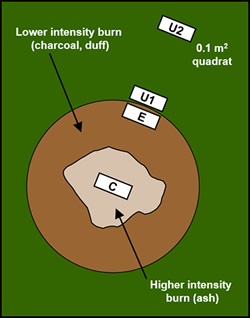| A fundamental challenge to restoring tree-invaded grasslands is the disposal of woody residues following tree removal. Broadcast and pile burning are two alternatives. Although pile burning may be easier to implement, it can generates intense, prolonged heating—shown to have adverse effects on forest soils and vegetation. Here we examine the long-term effects of pile burning on vegetation recovery following tree removal from conifer-invaded grasslands. This work extends our initial (3-yr) assessment of soil and vegetation responses (see Local effects of burn piles). Our objectives are to
- compare the abundance and diversity of plants
in and adjacent to burn scars;
- determine whether initially large differences in burn severity
at the centers and edges of scars persist after 7 yr; and
- interpret community recovery with respect to plant growth form
and clonality (potential for vegetative spread)
Methods
| Burn-pile sampling design |
 |
Schematic diagram of the sampling design:
C = scar center (higher-intensity burn)
E = scar edge (lower-intensity burn)
U1 and U2 = unburned vegetation at and distant from the edge. |
|
Sampling. Thirty burn scars were resampled in 2013 (7 yr after treatment). Each was sampled with a series of permanent 20 x 50 cm quadrats at four positions: scar center (C), edge (E), unburned edge (U1), and distant from edge (U2) (see diagram, right). Within each quadrat we estimated cover of bare ground, recent gopher disturbance (mounds or winter castings, convex in profile), and all plant species.
Analysis. Species were classified by growth form (grass, sedge, or forb) and clonality (limited/non-clonal or highly clonal). For each quadrat we tallied the number and summed the cover of species sharing each trait.
We used randomized block ANOVA to assess the effect of position on vegetation response (individual scars were treated as blocks). Significant effects were followed by post-hoc comparisons of means among positions. We also developed rank-abundance curves to compare the distribution of abundance and total richness of species among positions.
Halpern, C. B., J. A. Antos, and L. M. Beckman. 2014. Vegetation recovery in slash-pile scars following conifer removal in a grassland restoration experiment. Restoration Ecology 22:731-740. Request reprint |
|
| Recovery of burn scars |
| Year 1 (2007) |
_Plot-13_6-Jul-2007_199x300.jpg) |
| Year 7 (2013) |
_2013_199x300.jpg) |
| Burn scar 1 and 7 years after pile burning. PVC posts mark corners of quadrats; a sampling frame is visible in the 2007 photo. |
|
|
|
![]()
![]()
![]()
![]()
_13%20Ju%202009_sm.jpg)


_Plot-13_6-Jul-2007_199x300.jpg)
_2013_199x300.jpg)